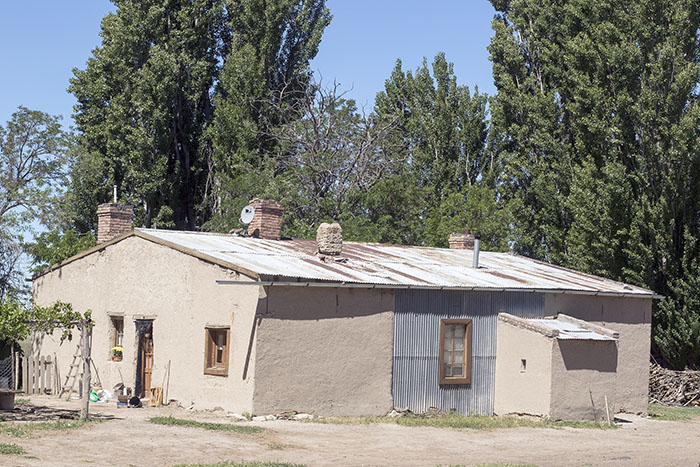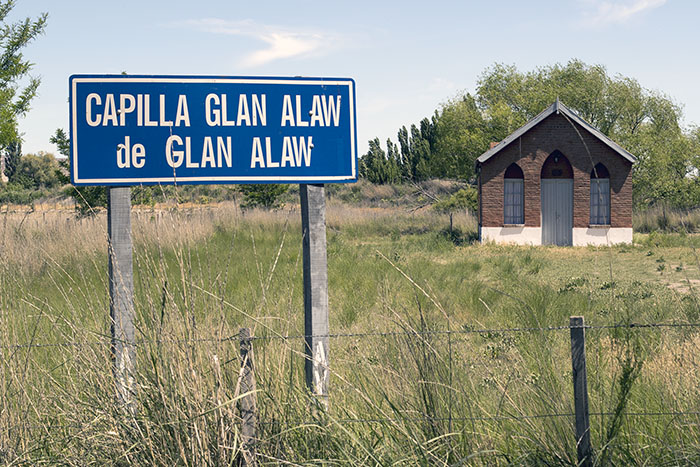Thursday 17 November, 2016; around the Chubut Valley
Today started and finished in Gaiman and was devoted to learning about the Welsh colonisation and the development of their settlements. But the first event turned out to be the arrival in Gaiman of the Rally of the Incas, a 10.000km drive from Buenos Aires to Lima that took in a good part of Patagonia too.

Rally drivers outside one of Gaiman’s many tea houses
We had known about the rally beforehand, and had arranged to be here at this time. It was lovely to see the fifty or so old cars driving through the town. Many of them were from the 1920s, and there seemed to be a predominance of Bentleys. The full list of participants can be found here.

The oldest car in the rally, a 1925 Bentley Super Sports
The organisers had come prepared for Gaiman with a suitably clothed Welsh mannequin that everyone wanted to pose with. The woman in this photograph was one of the waitresses from the Ty Gwyn tea house, where all the drivers had stopped for early morning tea and cakes.

Young woman from Gaiman poses with mascot mannequin brought from Wales
As the dust from the last cars settled we began to explore the town and its environs. Below you can see a rather lovely tree carving that grabbed our attention …

Woodcarving at Gaiman
… and one of the many irrigation ditches that keep the Chubut valley so fertile. Not one of the original ditches, obviously. Huge tracts of the valley were irrigated by the early colonists without the use of modern technology and materials: a monumental effort that made the land possible to farm and live in.

One of the countless irrigation ditches that keep the Chubut valley so fertile
The picture below, showing a wall built much as they are today in Wales, was one of the few stone structures we saw (although we were told of one old stone house in Gaiman which we didn’t see ourselves). We heard that the original settlers had left the first settlement at Rawson (named after Guillermo Rawson, a C19th politician) because there was no natural wood or stone there (their first homes had been constructed with wood brought over on the Mimosa), and presumably Gaiman was in some ways better for construction. We know that stone was to be found in and around Gaiman to some extent: the name Gaiman, refers to ‘sharp’ stone, or perhaps a ‘whetstone’; the word has never really been satisfactorily translated from the Tehuelche.

Gaiman was a good place for the Welsh to settle because of the availability of stone
We visited the nearby Bryn Gwyn Paleontological Park; Bryn Gwyn in Welsh means ‘white hill’. Although it was scorchingly hot, Caroline ventured a way along the trail while Martin watched a few birds playing near the [shaded] visitor centre. The Park is currently semi-open (all structures have been dismantled though you can still walk the trail) and it seems unclear when the new structures will be in place.

Entrance to the trail at Bryn Gwyn Paleontological Park
We were looking for old buildings from the Colonists era. Very little remains of the first settlers, but we did find Bod Iwan (see below). This house was built by the Welsh colonists for the family of Llwyd ap Iwan, who was shot dead by bandits in 1909.

Bod Iwan, one of the oldest Welsh farms still standing in the Chubut valley
The Chubut valley is peppered with chapels, many of which are still standing and quite a few in use.The delightful Glen Alaw (below) is the smallest.

The smallest of the Welsh chapels that scatter the valley
Of course you can’t leave Welsh Patagonia without a traditional Welsh Tea. Gaiman has many tea houses to choose from, and we plumped for one of the oldest, Plas y Coed, in the Centre of town. Welsh teas really are something else; one should go when really hungry and be prepared not to eat again for the rest of the day.

An inevitable tea at the Plas y Coed tea house
As we left Gaiman for our apartment hotel in Trelew we passed the Bethel Chapel and pulled in to take a photo. We were hailed by a very Welsh looking lady, Luned Roberts de González, who turned out to be the mother of Fabio whom we had met a couple of days earlier in the Gaiman Welsh settlers’ museum. We also met Jeremy Wood of WelshPatagonia, originally from New Zealand, who we had met an hour earlier in the Plas y Coed tea house and he invited us to a talk Luned was giving to the people on his tour.

The ‘new’ Bethel church at Gaiman
Luned’s talk, given in the older of the two Bethel Chapels (a larger one was needed for the growing congregation) was a fascinating mix of history and anecdote. She and her recently deceased sister Tegai are direct descendants of the first settlers and she knows all there is to know about the Welsh community.

Luned Roberts de Gonzáles
We must have spent a good hour, perhaps longer, listening to Luned before we headed back to Trelew, our bellies so full of Welsh tea that more food was not possible. Wine and beer helped us through till bedtime.

Inside the ‘old’ Bethel chapel
‘Luned Roberts de Gonzales’ is I think the strangest name I’ve ever come across.